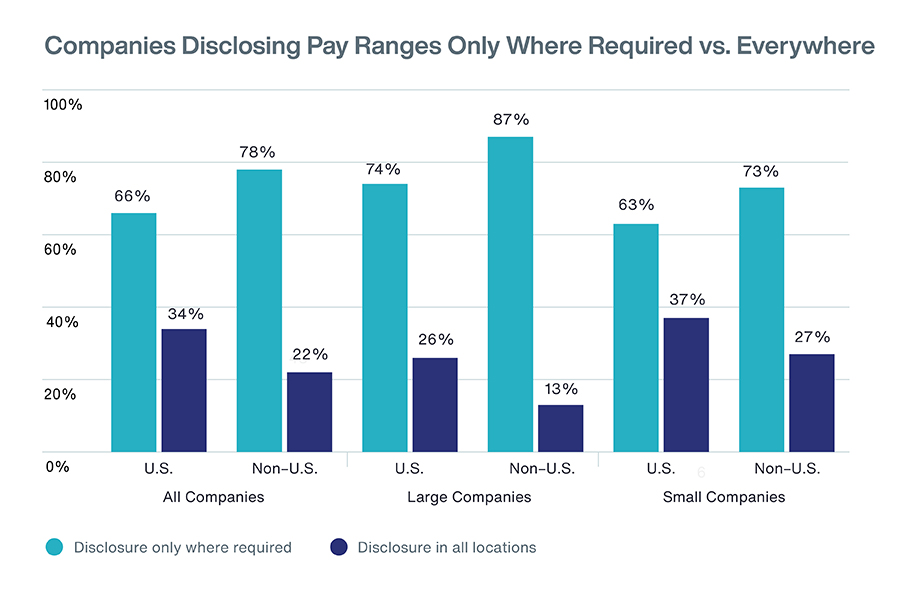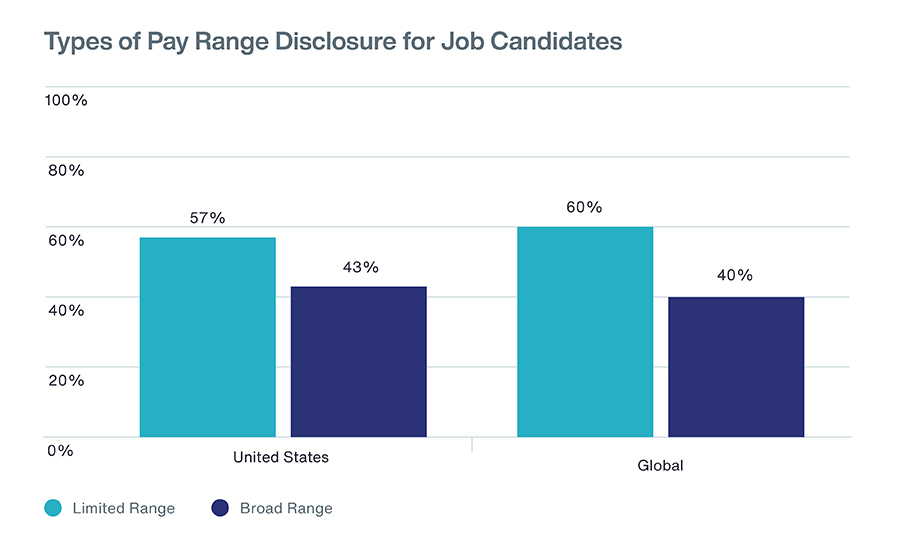More Like This
-
Capability Overview
Talent and Rewards
-
Capability Overview
Pay Equity
-
Article
Navigating the New EU Directive on Pay Transparency

The topic of pay transparency has become increasingly important as regulators, politicians, the media and other interested parties across the globe continue to make it a subject that is now widely discussed.
The term “pay transparency” generally refers to the practice of openly sharing information about compensation with employees and job candidates. With pay transparency sparking a patchwork of laws in different countries around the world, many companies are now asking how they should manage the practicality of disclosure.
There are a number of issues to consider regarding pay transparency laws and their long-term implications.
Capability Overview
Talent and Rewards
Capability Overview
Pay Equity
Article
Navigating the New EU Directive on Pay Transparency
In the European Union, there are several considerations for companies governed by the EU directive. Many firms are aware of pay transparency regulations, but still assessing how they will impact their business. EU member states have until June 2026 to “transpose” the directive to national legislation. The directive requires companies to publish information on the pay gap between female and male workers. Where a gender pay gap of 5 percent or more exists, employers will also be required to work with their employee representatives/works councils to conduct a deeper analysis and develop a corrective action plan. Furthermore, job applicants will have the right to receive information on the initial pay range for any advertised position and employers cannot ask about previous or current pay. Employers must also share information on how pay is set, progressed and managed.
Only 21 percent of more than 250 companies with employees in the EU have a pay transparency plan in place, according to Aon’s August 2023 Pay Transparency Readiness survey. Thirty-seven percent of respondents are considering how the rules will impact their firm and don’t yet know the actions they should take.
In 2022, the UK government announced a pilot program to encourage companies to disclose salaries for all job openings to help encourage more transparency and close the gender pay gap. In 2023, the government said any pay transparency rules, including the pilot program, will be under consideration by a new Inclusion at Work Panel. There is speculation the UK will adopt rules similar to the EU directive. In fact, 87 percent of senior HR leaders surveyed by Aon in the UK and EU in 2023 said they believed the EU directive would impact UK companies.
Pay transparency laws in the U.S. are relatively new and differ by city and state, prompting companies to stay on top of compliance. Roughly two-thirds of U.S. companies share pay range data only where legally required. The remaining one-third share ranges with candidates seeking that information in any location, according to survey responses from more than 700 respondents across the globe to Aon’s 2023 Pay Administration Report (offered as part of the 2023 Aon Radford Market Practices Study Suite). Larger companies are likely to focus on compliance, while smaller companies more often embrace an open disclosure policy. This difference is likely due to smaller companies operating in fewer locations, which means fewer policies to manage.

Many U.S. pay transparency rules require companies to disclose the pay scale for an open job. But it’s up to employers to decide if they disclose a more limited pay range or the full potential salary an employee may one day receive. There are pros and cons about how much information to share with candidates for the job.

Only 21 percent of more than 250 companies with employees in the EU have a pay transparency plan in place.
Aon’s August 2023 Pay Transparency Readiness survey
In the U.S., the legal aspects of sharing pay information focuses primarily on job applicants. Pay range data informs candidates, thus providing a more level playing field for salary negotiation and the prevention of issues like pay compression. Internal communication about pay ranges is a natural offshoot of pay transparency laws. Indeed, efforts to improve pay equity often start with greater information sharing.
Limiting disclosures to only outside candidates could harm employee relations and negatively impact company culture. At the same time, a company needs to carefully consider the repercussions of sharing pay ranges with existing employees. This information could expose pay equity gaps or cause employees to wonder why they are paid differently (or perhaps not as high as expected based on tenure) than the pay range disclosed for open roles like theirs.
Sharing information with current employees is much less common than sharing hiring pay data with managers. Around 40 percent of U.S. respondents do not share any pay range data with employees. That figure rises to 55 percent outside the U.S. However, once some employees do access pay data, it’s likely that they will share this information with their colleagues. A survey from beqom in March 2023 found that rising inflation was driving more candid conversations among colleagues around income. In fact, sixty-three percent of UK workers and 58 percent of U.S. workers said they are more likely to discuss pay with their colleagues in the current inflationary environment.
About one-third of companies surveyed in the U.S. share salary ranges with candidates seeking that information in any location — not just where legally required.
Aon’s 2023 Pay Administration Report
Interpreting and complying with new pay transparency laws is a key component of the pay transparency movement. But it’s just one of several aspects to consider. Other actions include:
Reach out to our team to discuss how to get started or visit our Talent and Rewards site to learn more.
General Disclaimer
This document is not intended to address any specific situation or to provide legal, regulatory, financial, or other advice. While care has been taken in the production of this document, Aon does not warrant, represent or guarantee the accuracy, adequacy, completeness or fitness for any purpose of the document or any part of it and can accept no liability for any loss incurred in any way by any person who may rely on it. Any recipient shall be responsible for the use to which it puts this document. This document has been compiled using information available to us up to its date of publication and is subject to any qualifications made in the document.
Terms of Use
The contents herein may not be reproduced, reused, reprinted or redistributed without the expressed written consent of Aon, unless otherwise authorized by Aon. To use information contained herein, please write to our team.
Our Better Being podcast series, hosted by Aon Chief Wellbeing Officer Rachel Fellowes, explores wellbeing strategies and resilience. This season we cover human sustainability, kindness in the workplace, how to measure wellbeing, managing grief and more.
Expert Views on Today's Risk Capital and Human Capital Issues
The construction industry is under pressure from interconnected risks and notable macroeconomic developments. Learn how your organization can benefit from construction insurance and risk management.
Stay in the loop on today's most pressing cyber security matters.
Our Cyber Resilience collection gives you access to Aon’s latest insights on the evolving landscape of cyber threats and risk mitigation measures. Reach out to our experts to discuss how to make the right decisions to strengthen your organization’s cyber resilience.
Our Employee Wellbeing collection gives you access to the latest insights from Aon's human capital team. You can also reach out to the team at any time for assistance with your employee wellbeing needs.
Explore Aon's latest environmental social and governance (ESG) insights.
Our Global Insurance Market Insights highlight insurance market trends across pricing, capacity, underwriting, limits, deductibles and coverages.
How do the top risks on business leaders’ minds differ by region and how can these risks be mitigated? Explore the regional results to learn more.
Our Human Capital Analytics collection gives you access to the latest insights from Aon's human capital team. Contact us to learn how Aon’s analytics capabilities helps organizations make better workforce decisions.
Explore our hand-picked insights for human resources professionals.
Our Workforce Collection provides access to the latest insights from Aon’s Human Capital team on topics ranging from health and benefits, retirement and talent practices. You can reach out to our team at any time to learn how we can help address emerging workforce challenges.
Our Mergers and Acquisitions (M&A) collection gives you access to the latest insights from Aon's thought leaders to help dealmakers make better decisions. Explore our latest insights and reach out to the team at any time for assistance with transaction challenges and opportunities.
How do businesses navigate their way through new forms of volatility and make decisions that protect and grow their organizations?
Our Parametric Insurance Collection provides ways your organization can benefit from this simple, straightforward and fast-paying risk transfer solution. Reach out to learn how we can help you make better decisions to manage your catastrophe exposures and near-term volatility.
Our Pay Transparency and Equity collection gives you access to the latest insights from Aon's human capital team on topics ranging from pay equity to diversity, equity and inclusion. Contact us to learn how we can help your organization address these issues.
Forecasters are predicting an extremely active 2024 Atlantic hurricane season. Take measures to build resilience to mitigate risk for hurricane-prone properties.
Our Technology Collection provides access to the latest insights from Aon's thought leaders on navigating the evolving risks and opportunities of technology. Reach out to the team to learn how we can help you use technology to make better decisions for the future.
Trade, technology, weather and workforce stability are the central forces in today’s risk landscape.
Our Trade Collection gives you access to the latest insights from Aon's thought leaders on navigating the evolving risks and opportunities for international business. Reach out to our team to understand how to make better decisions around macro trends and why they matter to businesses.
With a changing climate, organizations in all sectors will need to protect their people and physical assets, reduce their carbon footprint, and invest in new solutions to thrive. Our Weather Collection provides you with critical insights to be prepared.
Our Workforce Resilience collection gives you access to the latest insights from Aon's Human Capital team. You can reach out to the team at any time for questions about how we can assess gaps and help build a more resilience workforce.

Article 8 mins
Hurricanes Helene and Milton insured loss estimates are expected to fall between $34 billion and $54 billion. Healthy, well-capitalized insurance and reinsurance markets are positioned to absorb those losses.

Article 17 mins
Buyer-friendly conditions continued across much of the global insurance market in Q3, painting a largely positive picture as we head into year-end renewals.

Article 10 mins
A successful M&A strategy relies on due diligence across financial, legal, human capital, technology, cyber security and intellectual property risks. As cyber threats become more complex, robust cyber due diligence in private equity and acquisitions is increasingly necessary.